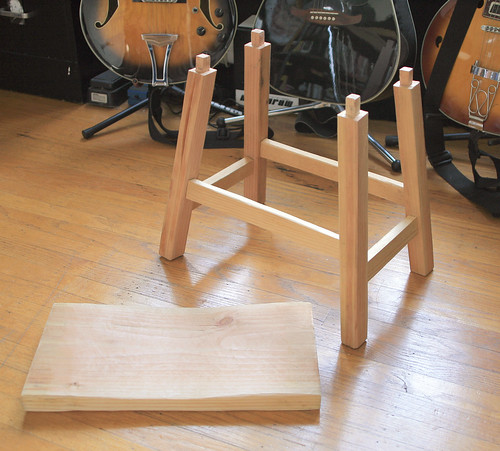
The goal was to do a project that did not involve my iMac (I guess until right now..): build a chair! This is a traditional Chinese / Japanese design, or as at least as close as I could get by studying the one I already have, and consulting with a colleague who made one many years ago in China (thanks Zhong-Min!). Fig. 1 is the final result (plus Veronica the cat) and Fig. 2 is my inital concept (argh more iMac). This was my first woodworking project. I used scrap pine boards, which felt like less pressure. I’ll try nice hardwoods next time.
I had three rules:
1. No power tools.
2. No nails or glue.
3. No sandpaper or paint.
The idea behind Rule #1 was to spend some ‘quality time’ with the wood, using only hand tools, many of them Japanese. This meant spending _much_ quality time learning how to sharpen the blades! But boy did they end up sharp…
The idea behind Rule #2 was to learn how to make mortise and tenon joints. I ended up making twelve pegged, blind (i.e. ‘stub’ or ‘stopped’) tenon joints. The trick here was that every joint was at a 97 degree angle. This required some iMac-sketching and head-scratching (Fig. 3). For the 8 rail joints, I angled the mortise, and for the 4 leg-seat joints I angled the tenon, in both the x and y directions (Fig. 4). In doing the latter I screwed up some angles, and hence had to violate Rule #2. A sort of chain reaction of bad angles necessitated a reworking of all 12 joints, so that they no longer fit perfectly and required some wood glue. Luckily, making the 1/8" hardwood pegs was satisfying and successful!
Rule #3 was intended to leave the wood surface feeling ‘like wood’. I read a great furniture artisan book from the SF Library (can’t remember the title) that advocated the use of a scraper to take off thin, single shavings from the surface, leaving a superior finish to sandpaper, which creates hundreds of miniature cuts. Pretty neat. A combination of blue and green stains ended up quite vivid.
Slow work…but all in all very enjoyable!
The tools (Fig. 5)…Japanese and Western mortise gauges. Gimlets for hand-drilling holes. Japanese saw, chisel, and mortise chisel. Drawknife for shaping the curved seat. Arkansas stone and Japanese water stone for sharpening. Scraper. Mallet. Combination square. Old plane that didn’t work so great. Band clamp.
Tool sources and info:
Alameda Antique Faire
Japan Woodworker (Alameda)
Hida Tool (Berkeley)
Cliff’s Variety (San Francisco)
Books and Bookshelves [stains and inspiration] (San Francisco)
Robert Larson Hand Tools (San Francisco)
"Japanese Woodworking Tools" by Toshio Odate
"Hand Tools" and "Planes and Chisels" from the "Fine Woodworking on…" Series
"Woodworking" by Jackson, Day, and Jennings
"HOME BUILDING AND WOODWORKING IN COLONIAL AMERICA" by C KEITH WILBUR